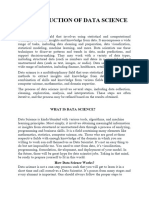Introduction to Data Science
What is Data Science?
Data science is the field that uses scientific methods, algorithms, and systems to extract insights
from data. It is a multi-disciplinary approach that combines statistics, computer science, and
domain-specific knowledge.
Key Aspects of Data Science
- Data Collection: Gathering data from multiple sources such as databases, APIs, web scraping,
and sensors. The quality and quantity of data are crucial to achieving accurate analysis and
predictions.
- Data Cleaning and Preprocessing: Cleaning involves removing or correcting errors and
inconsistencies in the data. Preprocessing includes handling missing values, scaling, and encoding
categorical variables.
- Exploratory Data Analysis (EDA): EDA involves using statistical techniques to understand data
patterns, relationships, and distributions, often using visualizations like histograms, scatter plots, and
box plots.
- Machine Learning: A core part of data science, machine learning builds models that can predict
future outcomes. Algorithms include supervised learning (e.g., regression, classification),
unsupervised learning (e.g., clustering), and reinforcement learning.
Popular Data Science Tools and Technologies
- Python and R: Preferred programming languages for data analysis, with libraries like Pandas,
�Numpy, Scikit-Learn, and ggplot2.
- SQL: Essential for database management and querying large datasets.
Data science has applications in finance, healthcare, marketing, and nearly every industry,
making it one of the most sought-after skills today.







































































